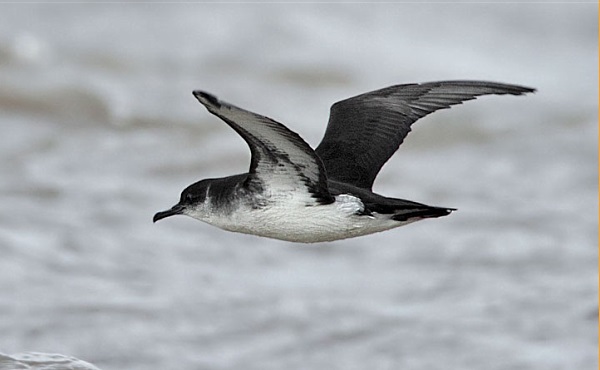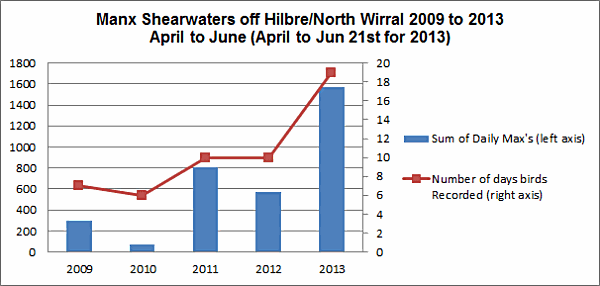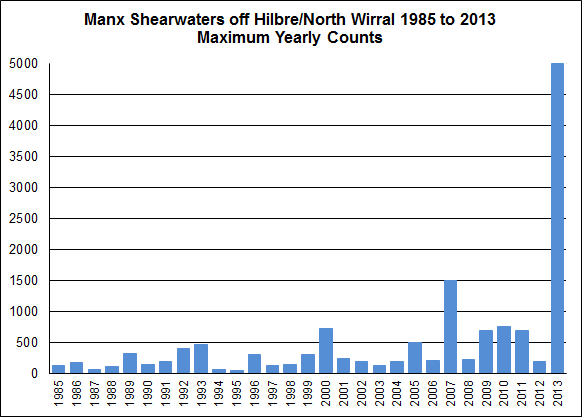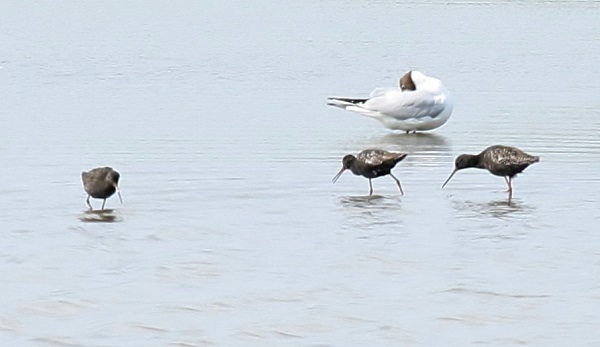Site menu:

July 2013 Newsletter
Manx Shearwaters - 2013.
June Bird News.
Forthcoming Events.
Latest Newsletter.
Manx Shearwaters - April to June 2013

So far 2013 has been an excellent one for Manx Shearwaters. As you can
see from the graph below even before the record breaking weekend of
June 22nd/23rd this April to June has seen significantly more birds on
more days than the previous four years.

The second half of June is often a peak
time for Manx Shearwaters as it is at this time that they are
incubating eggs and the partner which isn't on the nest typically is
away three to five days - ample time for them to reach Liverpool Bay
from their breeding colonies. So when the wind went round to WSW and
blowing force 6 to 7 on Saturday June 22nd I knew there was a good
chance of lots of 'Manxies'. I wasn't disappointed and nearly
1,000 were counted from
Hoylake shore, a very high count for Wirral. The next day the wind had
increased to force 7 to 8 and, perhaps significantly, the direction had
moved to WNW. The birds were streaming past in large numbers all day,
the
vast majority from east to west, and the total counted was over 5,000
from Hilbre and 3,000 from Hoylake, the count from Hilbre being the
highest ever recorded from Hilbre/Wirral. With their fast flight and up
and down glides they are an exciting bird to see at any time, but to
see so many was just fantastic!

Very large numbers of Manx Shearwaters breed in the Irish Sea with well over 50% of the world's population. Our nearest breeding colony is at Bardsey Island (off the Lleyn Peninsula in North Wales), a rapid increase in breeding birds at the end of the 20th century means there are currently around 12,500 pairs there, with possibly as many as 15,000 pairs. Across the Irish Sea, just south of Belfast Lough, 3,000 pairs breed on the Copeland Islands. But by far the largest colonies are on the Pembrokeshire islands of Skomer and Skokholm, a recent count on Skomer shows that numbers on this island are increasing with an enormous 316,000 pairs, plus there are about 50,000 pairs on Skokholm.
Work by Ronald Lockley in the mid 20th century suggested that, at that time, most birds from Skomer and Skokholm flew south to forage off Brittany and in the Bay of Biscay rather than north into the Irish Sea. However, some fascinating recent research, involving fitting Skomer birds with GPS tracking devices, has found that they must have changed their foraging area as the Irish Sea now appears to be their favourite feeding location. There is something called the Western Irish Sea Front (an area just to the west and south of the Isle of Man where two areas of water meet) which is rich in fish and many of the tracked birds visited here. None of them reached Liverpool Bay but apparently there is sometimes one of these fish rich Sea Fronts here as well and may be that is what is bringing the large numbers here this year. It seems more than likely that we see birds from all four colonies and with breeding birds still increasing we can expect to continue to see good size numbers, but the wind strength and direction no doubt plays a large part in determining exactly how close the huge Irish Sea flocks come to the coast. Interestingly, a year ago on June 22nd 2012, there was a Force 8 gale blowing from WSW, yet only 81 Manx Shearwaters were recorded that day - so there are definitely more around our part of the Irish Sea this year for whatever reason. The bar for 2013 in the graph above is, of course, for this year so far. July is often quite quiet but by August numbers should pick up again. It would be remarkable if that record count in June was exceeded this summer, but you never know!
References:
1. Lockley, R.M. (1953) On the movements of the Manx Shearwater at sea during the breeding season. British Birds 46:1-48.
2. Bardsey Bird and Field Observatory Report 2010.
3. Copeland Bird Observatory www.copelandbirdobservatory.org.uk.
4. Chris M. Perrins, et. al, A whole-island census of the Manx Shearwaters Puffinus puffinusbreeding on Skomer Island in 2011, SEABIRD 25 (2012): 1-13.
5. Guilford, T.C., et. al, GPS Tracking of the foraging movements of Manx Shearwaters Puffinus puffinus breeding on Skomer Island, Wales. Ibis 150(3):462-473, 2008.6. K. Lees and S. Mackinson, An Ecopath model of the Irish Sea, Technical Report no. 138, Cefas.
7. Species Spotlight - Manx Shearwater, Dee Estuary Newsletter June 2007.
8. Hilbre Bird Observatory Blog.
9. Cheshire and Wirral Bird Reports (CAWOS) - 1985 to 2011.
10. Dee Estuary Birding website, Latest Sightings and Archive.
Richard Smith.
Top of PageJune Bird News

Talking of terns there was some good news at the Shotton Common Tern colony where about 300 pairs are breeding for the first time since 2008. The Little Terns at Gronant were hard hit by the gales mentioned above, it wasn't so much the strong wind but rather the coincident spring tides pushed in by the gales which flooded some nests. Hopefully they can still have a good breeeding season and I'll let you have the news on this next month. An unexpected visitor to Gronant this month was a Short-eared Owl seen on several days.
There were several Red Kite records, including two over Dungeon Woods, Thurstaston, on the 21st plus several sighting of one near Ness Gardens. A Marsh Harrier was at Burton Mere Wetlands on the 18th.
Stonechats bred succesfully near Leasowe Lightouse, male photographed above. A Pectoral Sandpiper was recorded on several dates mid-month at Burton Mere Wetlands and there were up to six Spotted Redshanks there, plus a Greenshank at Thurstaston on the 16th. 450 Black-tailed Godwits on Donkey Stand Flash, Parkgate, on Jun 20th was a nice high count of this over-summering flock.
Presumably due to the cold weather earlier on this year there have been fewer Great White Egrets compared with 2012, but one was on Heswall Marsh on the 18th. A Corn Bunting was at Sealand, a good record for this increasingly rare bird.
What to expect in July
Gull numbers will increase dramatically and will include a few Mediterranean Gulls looking stunning in their breeding plumage. Out to sea will be Arctic Skuas harrasing all those terns, as well as good numbers of Gannets and, if we get strong winds, many Manx Shearwaters and hopefully some Storm Petrels.
Waders also return this month, specially the fresh water loving species such as Common Sandpiper, Green Sandpiper, Wood Sandpiper, Greenshank and Spotted Redshank. Rare waders which have been recorded this month over the past few years have included a Lesser Yellowlegs and Terek Sandpiper.
Top of Page
Forthcoming Events
July Highest Spring Tides (Liverpool)
Also
see Tides
page.
23rd July, 12.17hrs (BST), 9.5m.
24th July, 13.05hrs (BST), 9.6m.
25th July, 13.51hrs (BST), 9.5m.
Forthcoming Events
Organised by the Wirral
Ranger Service , Flintshire Countryside Service and/or the
RSPB:
All these events and walks have bird interest, even those not
advertised specifically for birdwatching. No need to book for these
events unless specified - please check below.
Also see 2013 Events Diary.
Sunset and Wildlife:
Join the Coastal Rangers and RSPB for an evening walk across the sands to Hilbre Island to discover its wildlife and history. Warm waterproof clothing, stout footwear or wellingtons are recommended. Bring binoculars if you have them.
Places are limited and a suggested donation of £3:00 will be gratefully received for this event.
Booking essential (0151) 648 4371.
Saturday 13th July 10:00am start, Marine Wildlife Workshop.
Interested in marine wildlife?
This event is for you!
Come along to Wirral Country Park, Thurstaston where the Sea Watch Foundation will be teaching you cetacean identification skills in readiness for the annual Whale and Dolphin Watch 2013. The RSPB will give a talk about seabird conservation in the marine environments and Cheshire Wildlife Trust will talk about marine wildlife conservation.
The workshop will be followed by a beach walk/scavenger hunt in the afternoon.
No need to book.
For further information telephone Wirral Country Park on (0151) 648 4371.
Saturday 20th July 11:00am – 4:00pm
Hilbre Birdwatch:
Join the Coastal Rangers and RSPB on this low water walk across the sands to Hilbre Islands to enjoy the island’s birds and wildlife. Suitable clothing, stout footwear or wellingtons are recommended. Bring binoculars if you have them. Places are limited and a suggested donation of £3:00 will be gratefully received for this event.
Booking is essential (0151) 648 4371
Saturday 3rd August 12:00noon – 4:00pm
Take Tea on Hilbre with the RSPB:
The return of last year’s event by popular demand! Cross the sands to Hilbre Island where the RSPB will be serving tea and cakes during the above times. They will be staffing the bird hide overlooking ‘Niffy Bay’.
To book for this event telephone (0151) 648 4371
Saturday 10th August 10:30am – 5:00pm
The Big Seawatch:
Join the Coastal Rangers, staff from the RSPB, Hilbre Bird Observatory and the Sea Watch Foundation for a day on Hilbre looking for seabirds, wading birds and cetaceans that inhabit our wonderful coast. We will be staying on Hilbre during high tide giving us the best chance to see them with experts on hand! Places are limited with a suggested donation of £5:00 for this event which includes tea/coffee. To book your place please ring (0151) 648 4371
Thursday 15th August 11:00am – 3:00pm
Mud Glorious Mud!
Join the Coastal Rangers and RSPB to find out what lives in the sand below our feet on Hoylake beach and learn about the birds that feed on the creatures that we might find! Please be aware that wellingtons are ESSENTIAL for this event and is not suitable for very young children. No need to book - just turn up between the above times. Meet at the Lifeboat Station, King’s Parade, Hoylake.
For further information please ring (0151) 648 4371
Saturday 17th August 12:00noon – 4:00pm
Take Tea on Hilbre with the RSPB:
The return of last year’s event by popular demand! Cross the sands to Hilbre Island where the RSPB will be serving tea and cakes during the above times. They will be staffing the bird hide overlooking ‘Niffy Bay’.
To book for this event telephone (0151) 648 4371
